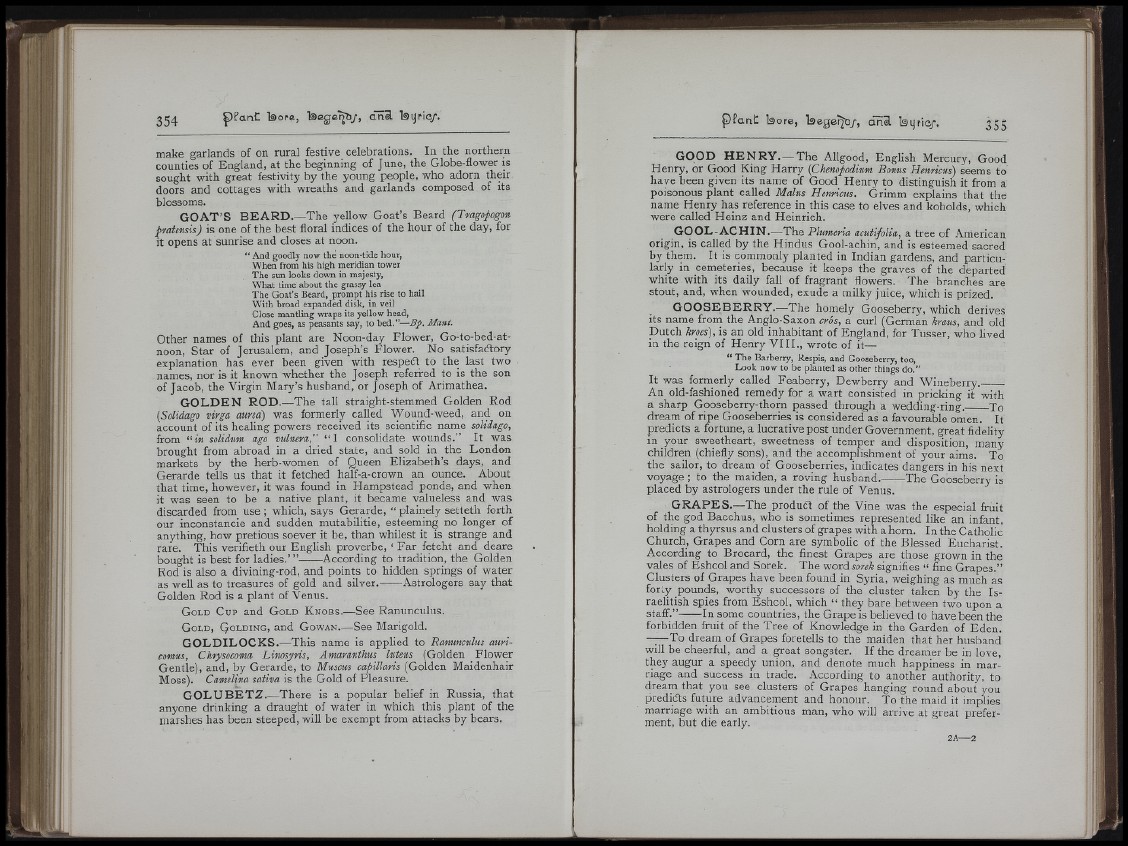
f J
make garlands of on rural festive celebrations. In the northern
counties of England, at the beginning of June, the Globe-flower is
sought with great festivity by the young people, who adorn their
doors and cottages with wreaths and garlands composed of its
blossoms.
G O A T ’ S B E A R D .—The yellow Goat’s Beard (Tragopogón
pratensis) is one of the best floral indices of the hour of the day, for
it opens at sunrise and closes at noon.
“ And goodly now the noon-tide hour,
When from his high meridian tower
The sun looks down in majesty,
What time about the grassy lea
The Goat’s Beard, prompt his rise to hail
With broad expanded disk, in veil
Close mantling wraps its yellow head,
And goes, as peasants say, to bed.”—Bp. Mant.
Other names of this plant are Noon-day Flower, Go-to-bed-at-
noon. Star of Jerusalem, and Joseph’s Flower. No satisfadlory
explanation has ever been given with respefl; to the last two
names, nor is it known whether the Joseph referred to is the son
of Jacob, the Virgin Mary’s husband, or Joseph of Arimathea.
G O L D E N RO D .—The tall straight-stemmed Golden Rod
[Solidago virga aurea) was formerly called Wound-weed, and on
account of its healing powers received its scientific name solidago,
from " in solidum ago vulnera,” “ I consolidate wounds.” It was
brought from abroad in a dried state, and sold in the London
markets by the herb-women of Queen Elizabeth’s days, and
Gerarde tells us that it fetched half-a-crown an ounce. About
that time, however, it was found in Hampstead ponds, and when
it was seen to be a native plant, it became valueless and was
discarded from use; which, says Gerarde, “ plainely setteth forth
our inconstancie and sudden mutabilitie, esteeming no longer of
anything, how pretious soever it be, than whilest it is strange and
rare. This verifieth our English proverbe, ‘ F a r fetcht and deare
bought is best for ladies.’ ” According to tradition, the Golden
Rod is also a divining-rod, and points to hidden springs of water
as well as to treasures of gold and silver. Astrologers say that
Golden Rod is a plant of Venus.
G o ld Cup and G o ld Knobs.—See Ranunculus.
G o ld , Qolding , and Gowan.— See Marigold.
G O L D IL O C K S .—This name is applied to Ranunculus auri-
comus, Chrysocoma Linosyris, Amaranthus luteus (Golden Flower
Gentle), and, by Gerarde, to Muscus capillaris (Golden Maidenhair
Moss). Camelina sativa is the Gold of Pleasure.
G O L U B E T Z .—There is a popular belief in Russia, that
anyone drinking a draught of water in which this plant of the
marshes has been steeped, will be exempt from attacks by bears.
GOOD H E N R Y . — The Allgood, English Mercury, Good
Henry, or Good King Harry (Chenopodium Bonus Henricus) seems to
have been given its name of Good Henry to distinguish it from a
poisonous plant called Malus Henricus. Grimm explains that the
name Henry has reference in this case to elves and kobolds, which
were called Heinz and Heinrich.
_GOOL-A C H IN .—The Plumeria acutifolia, a tree of American
origin, is called by the Hindus Gool-achin, and is esteemed sacred
by them. It is commonly planted in Indian gardens, and particularly
in cemeteries, because it keeps the graves of the departed
white with its daily fall of fragrant flowers. The branches are
stout, and, when wounded, exude a milky juice, which is prized.
G O O S E B E R R Y .—The homely Gooseberry, which derives
its name from the Anglo-Saxon cros, a curl (German kraus, and old
Dutch kroes), is an old inhabitant of England, for Tusser, who lived
in the reign of Henry V I I I ., wrote of it—
“ The Barberry, Respis, and Gooseberry, too,
Look now to be planted as other things do.”
It was formerly called Feaberry, Dewberry and Wineberry.
An old-fashioned remedy for a wart consisted in pricking it with
a sharp Gooseberry-thorn passed through a wedding-ring. To
dream of ripe Gooseberries is considered as a favourable omen. It
predicts a fortune, a lucrative post under Government, great fidelity
in your sweetheart, sweetness of temper and disposition, many
children (chiefly sons), and the accomplishment of your aims. To
the sailor, to dream of Gooseberries, indicates dangers in his next
voyage ; to the maiden, a roving husband. The Gooseberry is
placed by astrologers under the rule of Venus.
G R A P E S .—The produfl; of the Vine was the especial fruit
of the god Bacchus, who is sometimes represented like an infant,
holding a thyrsus and clusters of grapes with a horn. In the Catholic
Church, Grapes and Corn are symbolic of the Blessed Eucharist.
According to Brocard, the finest Grapes are those grown in the
vales of Eshcol and Sorek. The word soreh signifies “ fine Grapes.”
Clusters of Grapes have been found in Syria, weighing as much as
forty pounds, worthy successors of the cluster taken by the Is-
raelitish spies from Eshcol, which “ they bare between two upon a
staff,” In some countries, the Grape is believed to have been the
forbidden fruit of the Tree of Knowledge in the Garden of Eden.
--—To dream of Grapes foretells to the maiden that her husbanc
will be cheerful, and a great songster. I f the dreamer be in love,
they augur a speedy union, and denote much happiness in marriage
and success in trade. According to another authority, to
dream that you see clusters of Grapes hanging round about you
predifls future advancement and honour. To the maid it implies
marriage with an ambitious man, who will arrive at great preferment,
but die early.
2 A 2
Í
I Hl\